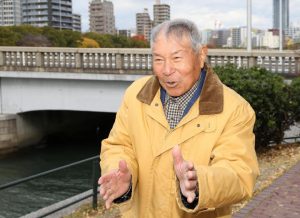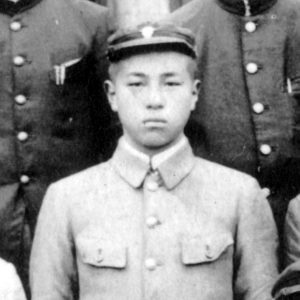Survivors’ Stories: Akira Takeuchi, 88, Nishi Ward, Hiroshima
Dec. 6, 2021
With face and arm badly burned, prepared himself for death
Replacement of gauze bandages each morning was so painful
by Rina Yuasa, Staff Writer
Akira Takeuchi, 88, experienced the atomic bombing when he was 12 years old in a schoolyard about two kilometers from the hypocenter, suffering burns to the right side of his face and right arm. After the war, he erected a shack and an iron foundry upon the scorched ruins of his house and did everything he could to make a living. Looking back on his life, Mr. Takeuchi has said, “I survived because I was lucky enough to have been helped by so many.”
There were five people in his family: Akira; his father, Shigeru (then 45); his mother, Mihako (then 41); and two younger brothers. His house was located in the neighborhood of Higashikanon-machi (now part of Hiroshima’s Nishi Ward) along the Tenma River, where he often played and enjoyed swimming. Around 1945, his father Shigeru, who ran a small factory at his house that manufactured stone powder used as coating material for warships, had been hospitalized for treatment of tuberculosis at the Mitaki clinic of the Hiroshima Army Hospital.
Mr. Takeuchi was a first-year student at the Hiroshima Prefectural Hiroshima Commercial School (now Hiroshima Prefectural Hiroshima Commercial High School). On the morning of August 6, 1945, he was lined up in the schoolyard of the former Hiroshima Normal School, located in what was known as Minami-machi (now part of the city’s Minami Ward) in preparation to move on to a site where students were being mobilized to help tear down buildings to create fire lanes.
The students typically left the schoolyard at 8:00 a.m. On that day, however, the staff meeting had dragged on. He happened to catch a glimpse of an American B29 bomber in the sky. As he placed his right arm over his eyes to block glare from the bright sky, he was suddenly bathed in a flash of light. After regaining consciousness, he found himself on the ground with the area engulfed in pitch darkness from clouds of dust. He imagined that a bomb had been dropped on a gas tank.
He walked to Hijiyama Bridge in an effort to return to his house, but the road ahead was aflame, blocking his path forward. The right side of his face and his right arm had turned bright red after the skin had peeled off. He quickly jumped into the Kyobashi River to cool down. When he clambered up to the riverbank, he witnessed hordes of people, who all said, “Get to Ujina.” He followed the crowd of wounded, eventually reaching a military hospital (now the Hiroshima Prefectural Hospital in the city’s Minami Ward). He was placed on a board and had oil applied to his face and other parts of his body. At night, he was allowed to stay in the sewing room of the nearby Hiroshima Prefectural College for Women (now Hiroshima Prefectural University in Minami Ward).
On the morning of August 9, Mihako, who was exposed to the atomic bombing at home, and two factory workers came to pick him up. Mr. Takeuchi was transported in a large two-wheeled cart to a hospital run by relatives in the area of Gion (now part of Hiroshima’s Asaminami Ward). He still remembers the doctor saying nothing could be done for him.
Prepared to die, Mr. Takeuchi’s mind was filled with pain and suffering. His pain was severe, especially each morning when a nurse changed the gauze bandages stuck to his wounds. Despite that, he was discharged from the hospital about one month later, because the treatment proved to be effective.
At the end of August, Mr. Takeuchi headed for Konu Village (now part of Miyoshi City), which was his mother Mihako’s hometown. On the way, he visited his father Shigeru, who was staying in a national school after experiencing the atomic bombing at the Hiroshima Army Hospital. Shigeru passed away on September 3.
Mr. Takeuchi’s family lost its breadwinner, and all 16 of the factory employees scattered elsewhere. His house and his father’s factory were lost in the fires that arose after the bombing. When the school reopened in November of that year in the area of Eba-machi (now part of Hiroshima’s Naka Ward), Mr. Takeuchi commuted to the school from a relative’s house in the Rakurakuen region (now part of Saeki Ward). The following year, he erected a shack on top of the scorched ruins of his house and, while experiencing a variety of hardships, he and his mother and two younger brothers started putting their lives back together.
With reform of Japan’s school system after the war, Mr. Takeuchi became a second-year student of the business curriculum at Kanon High School. After graduation, he built an iron foundry on the ruins of his house and began selling the material. He married his wife, Yukari, at the age of 28, and together they had two children. Since growing old, he has tried to keep himself fit by swimming, one of his hobbies. Two years ago, he participated in a Japan Masters Swimming short-course competition and was ranked 24th in the nation in the 25-meter freestyle event for men aged 85 to 89. He has also been involved in activities of the Boy Scouts, an organization to which his oldest son belonged, for the past 45 years.
Mr. Takeuchi explains, “To avoid war, it’s important to continue to positively engage in communication with others even if opinions are in conflict.” In his work as neighborhood association president, he constantly places a top priority on that philosophy.
(Originally published on December 6, 2021)









